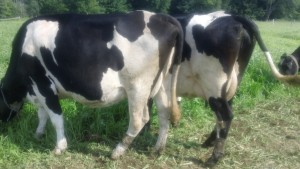By: Juan P. Alvez | Pasture Technical Coordinator
UVM Center for Sustainable Agriculture
A recently-completed research project yielded interesting results regarding dairy cows’ productivity and how much time they spent laying in the field.
Cow’s day time behavioral activities can be roughly divided by: feeding (3-5 h per day); resting (12-14 h); social interaction (2 to 3 h); rumination (7-10 h); water ingestion (30 min) other management activities (2 h) with some of these overlapping.
Ideally, most cows lay down for over a third of the day. If you see a cow standing while the majority are resting, feeding, ruminating, socializing o drinking water, you must observe its behavior and check whether there is adequate supply of feed, quality water, space or flight zone space.
In a study performed by a team of University of Vermont researchers* at an organic dairy in Franklin County, Vermont, we verified that cows with longer laying bouts were the most productive.
We fitted tri-axial accelerometers to eight Holstein dairy cows and studied their grazing behavior during 10 weeks, from June to September over three different diets: in-barn feed, cool season pastures, a warm-season grass (Wonderleaf Pearl Millet).
We found out that cows differ in lying time. The average lying time was a little over 9 hours (ranging from 6 to 12h). We found no effects of pasture regime on lying time but the higher producing cows had longer lying times.
In sum, cows don’t work overtime, and they may get more productive when resting for longer time.
*Research Team: John Barlow, Jana Kraft, Joe Roman, Juan Alvez and Melissa Bainbridge
The stydy was funded by NE SARE (Project ONE14-196)
Have you explored different successful livestock-forage ideas? We would love to hear and maybe test them! You can share your observations by dropping us a line at the UVM Pasture Program:
Juan Alvez (jalvez@uvm.edu); Kimberly Hagen (kimberly.hagen@uvm.edu) and, Jennifer Colby (jcolby@uvm.edu)



Recent Comments